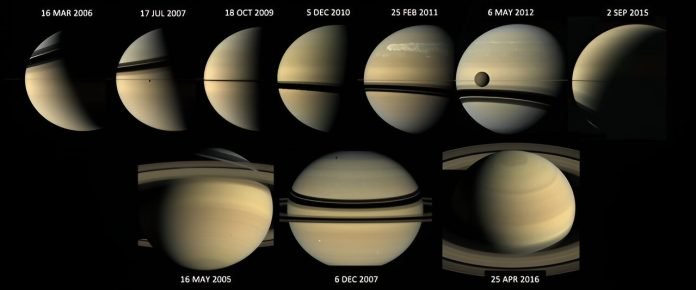
Scientists have been using a super-advanced telescope called the James Webb Space Telescope (JWST) to look at Saturn, and what they’ve found is both exciting and surprising.
Like Earth, Saturn experiences changes in weather depending on the time of year.
The only difference?
A single season on Saturn lasts for about 7.5 Earth years because it takes the planet 30 years to go around the Sun!
Researchers from the University of Leicester in the UK used a special tool on JWST called MIRI to look at Saturn’s atmosphere.
They used this tool to measure temperature, find out what gases are in the air, and even look at clouds. What’s so cool about MIRI is that it can break down the light it captures into different parts, helping scientists figure out what elements make up Saturn’s air.
So, what have they found? One of the coolest things they observed is a massive, warm whirlpool of air at Saturn’s north pole.
They call this the north-polar stratospheric vortex. It’s so huge that it’s about 1,500 km wide! This warm whirlpool was first spotted by an earlier mission called Cassini, and it’s stayed warm because of the sunlight during Saturn’s long summer season.
But now, as Saturn is heading into its autumn in 2025, things are changing. This big, warm whirlpool is starting to cool down. It will eventually go away as Saturn’s north pole moves into the darkness of a long winter.
Meanwhile, the overall atmosphere is also changing. Air that used to flow from the planet’s southern part to its northern part is now going the other way around.
The scientists noticed these changes by comparing new data to what Cassini observed years ago. Cassini saw warm temperatures and a lot of gases like ethane in the northern part of Saturn during its winter.
Now, the JWST’s new observations reveal that the northern part between specific latitudes (10oN to 40oN) is cooler and has fewer of these gases. This suggests that the air is now flowing in a new direction.
Dr. Oliver King, a researcher, said Saturn was chosen for these observations because it’s a challenging target.
It’s big, bright, and always moving, which really tests the JWST’s capabilities. The team took multiple pictures, or “tiles,” from Saturn’s equator to its north pole, and even included the famous rings in their study.
Professor Leigh Fletcher, who led the research, mentioned how excited the whole team was when they saw the new data. He said this kind of detailed information was never accessible before and imagines the many more discoveries that could come from this new telescope.
So there you have it! Saturn is experiencing some big weather changes, and scientists are thrilled to get this close-up view. And the best part? This is just the beginning, and more amazing findings are sure to come!
The study was published in Journal of Geophysical Research: Planets.
Follow us on Twitter for more articles about this topic.



